Featured Articles
RINGSIDE REPORT McCarson on the Maidana-Broner Card
Welterweight Marcos Maidana solved “The Problem” in fine fashion Saturday night at the Alamodome in San Antonio, Texas. Maidana defeated Broner by unanimous decision 115-110, 116-109 and 117-109.
The problem with Adrien Broner is that he believes he is Floyd Mayweather. The issue with that, of course, is Broner doesn’t really understand who or what Mayweather really is. Mayweather is the consummate professional. His work ethic is unparalleled in the sport, and for all the glitz and glamour of his Money Team persona, Mayweather is as blue-collar as it gets in the places it counts most. He shows up on fight night of sound body and mind. He talks to the media, smiles for the cameras and takes pictures with fans. He signs autographs for hours and hours and hours.
Broner just wants the lifestyle. He’s brash, loud and arrogant. He wants to be celebrated for things he’s never done, and he acts as if he is already a living legend. At the weigh-in on Friday, he admonished fans who wanted autographs and rudely declined those in the media seeking quotes. He was too busy being so important, after all.
Maidana stunned Broner with a left hand early in Round 1. Broner waved him in and Maidana obliged. Maidana landed flush shots in a one-sided round. Broner was hurt but tried to play it off with showmanship and guile. A left hook sent Broner down to the canvas and set the tone for the rest of the night.
Maidana used a mixture of hard and wild punches. He hurt Broner badly in the second round. He was stumbling around the ring like a baby deer on ice at times. Broner gathered his wits about him by the end of the round but mostly got pummeled.
Both fighters got rough as the night wore on, but Broner consistently got the worse of things when it was all said and done. Sure, the gifted athlete had his moments. He was precise at times and made Maidana miss wide enough to earn some rounds, but Maidana was just too much grit, gumption and firepower. Broner was hurt in Round 3 by a hard left hook. Round 4 was fought at more a measured pace. Both did work from more of a distance than previous rounds. Broner landed jabs upstairs and down. Maidana kept the pressure on with unorthodox punching patterns.
In Round 5, Broner landed a nice uppercut to start out well, but Maidana erased it with a hard hook at the end of a three-punch combo. Back and forth it went. They were both landing punishing blows. Broner had his best round. Sure, he was still getting hit, but he also landed clean shots and dictated the pace of the round. Still, an undeterred Maidana threw the kitchen sink at him for good measure.
Broner did some fine work in Round 6. He took the fight to Maidana for most of the set, but again the hard-throwing Maidana landed heavy shots toward the end of the round.
Maidana threw punches in bunches in Round 7, and many of them landed. In Round 8, a booming left hook sent Broner down to the canvas again. The crowd cheered wildly. Broner did his best to hold Maidana and catch his breath. It worked, and Maidana lost his head a bit when he gave Broner a headbutt. Referee Laurence Cole immediately separated the men, taking a point away from the offender. Broner overly played up the foul, flailing around on the ground like a helpless child. Was he hurt as bad as he seemed? Or was he looking for a way out of the fight? Or maybe just a rest? Cole gave him a few minutes of respite, then ordered the men to continue.
Broner had a real problem now. He was still slowed from the Round 8 beating as Round 9 began. Maidana sensed it and came hard at him with thunderous blows. Broner tied him up, but Maidana landed a big left anyway. Then a right. Broner was hurt again. He moved quickly in retreat back and around the ring, but could not keep Maidana off of him. Another hard left was Broner’s punishment now. And another. Broner got his wits back when Maidana ran out of gas from all the punching, but it was a one-sided round for Maidana. Round 10 was back and forth. Broner was brave and proud. He would not suffer his first loss easily.
Maidana buzzed Broner to open Round 11, then Broner roared back with quick hooks and uppercuts. Then it was all Maidana again. He was a dominant force tonight. Broner hit Maidana after the bell. No point taken by Cole, but he called time and let Maidana rest an extra minute before the last round.
Round 12 was all Broner at the beginning, who must have known he needed a knockout to win. But Maidana, ever the willing warrior, spent the last minutes getting the better of some fantastically wild exchanges. When the final bell tolled, the pro-Maidana crowd cheered wildly for their man. He was the clear victor in perhaps the biggest upset of the year.
Thurman Takes Care of Soto Karass
Before the main event, welterweight Keith Thurman handed the brave Jesus Soto Karass a savage nine-round beating to remain undefeated and on the rise.
“I’m here to entertain!” exclaimed Thurman afterwards, and he certainly did.
An overhand right from Soto Karass in Round 1 stunned Thurman who recovered and knocked Soto Karass silly by the end with an overhand of his own as well as a left hook to the temple. He was the stronger puncher and it showed throughout the fight.
Soto Karass stood his ground in Round 2, ripping hooks to Thurman’s torso. Both landed meaningful blows in a torrid three minutes of action. Soto Karass was warned for a low blow.
Soto Karass was relentless in Round 3, coming forward with punches high in both power and volume. He strafed Soto Karass around his midsection and ripped him up top with a hard right hand. Round 4 was similar. Soto Karass was content to grind forward while Thurman circled to his left. Thurman is a smart fighter. He loaded up on punches likes hooks and uppercuts for counters to try and deter Soto Karass as much as possible.
After making Soto Karass miss more than any previous round, Thurman did real damage in Round 5. Thurman knocked Soto Karass down to his bottom, backwards into a neutral corner after a jab, cross, left hook combination. Thurman helped his adversary hit the deck with a slight forearm push on the way down after the hook had done it’s damage.
Thurman fought smart in Round 6, moving around and timing thunderous single punches from distance. Soto Karass was still pressing forward, but appeared tired and with less steam on his punches than before. Thurman’s jab and footwork was key to him taking Round 7, and a hard right hand didn’t hurt things either. Soto Karass did have a bit of success when pinning Thurman against the ropes, but it wasn’t enough to make traction.
Round 8 was close. While Soto Karass was pressing forward with constant pressure, Thurman’s counters seemed to lose their zip. Soto Karass landed a nice hook and right hand in the round that might have given him the edge, though Thurman connected with some missiles before the bell rang.
A hard right hand from Thurman in Round 9 sent Soto Karass reeling to start it, but the brave, tough warrior pressed on. Tired, hurt, and a little befuddled now, he stayed with his approach of sliding forward with small steps to close the distance on his opponent, an increasingly dangerous proposition. The end was near. Thurman stopped Soto Karass in his tracks with a tremendously powerful left hook, a right hand, then another, then a hook and another. The referee jumped in to stop it at 2:21 as poor Soto Karass fell down to his bottom in defeat.
Other Action
Light heavyweight Beibut Shumenov defeated Tomas Kovacs by Round 3 knockout. After the bout, Shumenov said he expected a bout with Bernard Hopkins in 2014.
Shumenov was the stalker against Kovacs. He worked his way into the fray behind a long jab, then opened up with a quick three-punch combo which ended with a left hook to knock Kovacs down near the end of Round 1. Kovacs took a count, but made it to his feet before 10. The bell sounded and he was free to continue. Shumenov played it safe in Round 2, working carefully but with enough aggression to keep Kovacs in danger. Kovacs took a knee from a left uppercut but got up to take several hard right hands.
Shumenov ate some right hands in the third, but used a stinging jab to keep Kovacs off balance enough until he could land a hard right hand to end things. Kovacs went down and the referee halted the bout at 2:55 of Round 3.
Super bantamweight Leo Santa Cruz outworked Cesar Seda over 12 rounds. It was a workmanlike effort from the universally loved volume puncher. Seda gave Santa Cruz various angles to keep his opponent from steamrolling over him, but couldn’t do enough to win many rounds. Judges at ringside scored it 116-11, 115-112 and 117-110 for Santa Cruz.
Bantamweight prospect Rau’Shee Warren defeated Jose Silveira by unanimous decision. Judges at ringside scored the bout 80-72 all three ways. Warren used fast and busy hands to befuddle his outclassed opponent over all eight rounds. The three-time Olympian said speed was a critical part of his arsenal as he moves forward in his transition from amateur to professional.
Former middleweight champion Jermain Taylor dominated J.C. Candelo on Saturday night. Taylor ended things with a jab-cross combo at 2:08 of Round 7. He was winning every round with a stiff jab and thunderous right hand, something he said he worked on rigorously during training camp. Taylor said he felt sharp in the bout, and that he expects a world title shot in 2014.
Lightweight prospect Robert Easter, Jr. looked the part of a future world champion in his short bout. The Cincinnati-based fighter used a hard left hook to double over Hardy Paredes of Chile in the very first round. The bout was called at :30 of Round 1.
Lightweight Jamel Herring dissected Lance Williams in just two rounds to continue his undefeated career. Herring scored two quick knockdowns in Round 2, then one more to finish him. Herring was a 2012 Olympian for the United States.
Finally, junior welterweight Ricardo Alvarez defeated Rod Salka by unanimous decision. Alvarez is one of Canelo’s older brothers, and does not appear as gifted.
-

 Featured Articles4 weeks ago
Featured Articles4 weeks agoThe Hauser Report: Zayas-Garcia, Pacquiao, Usyk, and the NYSAC
-
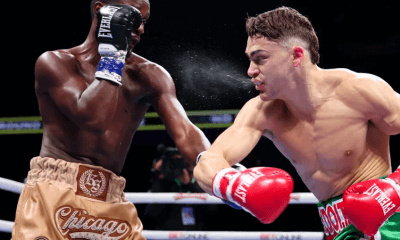
 Featured Articles3 weeks ago
Featured Articles3 weeks agoOscar Duarte and Regis Prograis Prevail on an Action-Packed Fight Card in Chicago
-
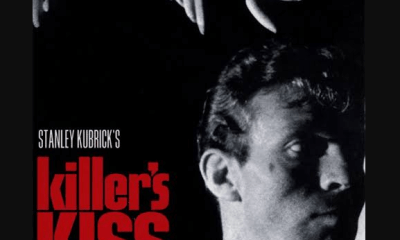
 Featured Articles2 weeks ago
Featured Articles2 weeks agoThe Hauser Report: Cinematic and Literary Notes
-
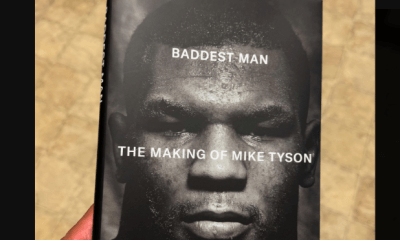
 Book Review2 weeks ago
Book Review2 weeks agoMark Kriegel’s New Book About Mike Tyson is a Must-Read
-

 Featured Articles4 weeks ago
Featured Articles4 weeks agoRemembering Dwight Muhammad Qawi (1953-2025) and his Triumphant Return to Prison
-
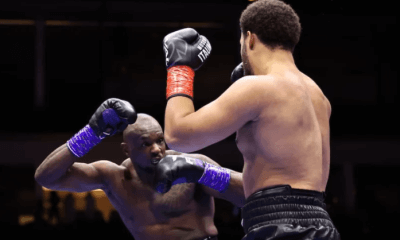
 Featured Articles7 days ago
Featured Articles7 days agoMoses Itauma Continues his Rapid Rise; Steamrolls Dillian Whyte in Riyadh
-
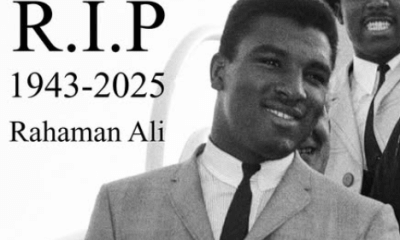
 Featured Articles3 weeks ago
Featured Articles3 weeks agoRahaman Ali (1943-2025)
-

 Featured Articles3 weeks ago
Featured Articles3 weeks agoTop Rank Boxing is in Limbo, but that Hasn’t Benched Robert Garcia’s Up-and-Comers













